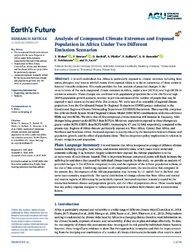Analysis of Compound Climate Extremes and Exposed Population in Africa Under Two Different Emission Scenarios
DOI: https://doi.org/10.1029/2019EF001473
Persistent URL: http://resolver.sub.uni-goettingen.de/purl?gldocs-11858/9425
Persistent URL: http://resolver.sub.uni-goettingen.de/purl?gldocs-11858/9425
Weber, T.; Bowyer, P.; Rechid, D.; Pfeifer, S.; Raffaele, F.; Remedio, A. R.; Teichmann, C.; Jacob, D., 2020: Analysis of Compound Climate Extremes and Exposed Population in Africa Under Two Different Emission Scenarios. In: Earth's Future, Band 8, 9, DOI: 10.1029/2019EF001473.
 |
Dokument öffnen: |
It is well established that Africa is particularly exposed to climate extremes including heat waves, droughts, and intense rainfall events. How exposed Africa is to the co-occurrence of these events is however virtually unknown. This study provides the first analysis of projected changes in the co-occurrence of five such compound climate extremes in Africa, under a low (RCP2.6) and high (RCP8.5) emissions scenario. These changes are combined with population projections for a low (SSP1) and high (SSP3) population growth scenario, in order to provide estimates of the number of people that may be exposed to such events at the end of the 21st century. We make use of an ensemble of regional climate projections from the Coordinated Output for Regional Evaluations (CORE) project embedded in the Coordinated Regional Climate Downscaling Experiment (CORDEX) framework. This ensemble comprises five different Earth System Model/Regional Climate Model (ESM/RCM) combinations with three different ESMs and two RCMs. We show that all five compound climate extremes will increase in frequency, with changes being greater under RCP8.5 than RCP2.6. Moreover, populations exposed to these changes are greater under RCP8.5/SSP3, than RCP2.6/SSP1, increasing by 47- and 12-fold, respectively, compared to the present-day. Regions of Africa that are particularly exposed are West Africa, Central-East Africa, and Northeast and Southeast Africa. Increased exposure is mainly driven by the interaction between climate and population growth, and the effect of population alone. This has important policy implications in relation to climate mitigation and adaptation.
Statistik:
ZugriffsstatistikSammlung:
Schlagworte:
compound climate extremespopulation exposure
regional climate change
Africa
CORDEX-CORE
regional climate models
This is an open access article under the terms of the Creative Commons Attribution License, which permits use, distribution and reproduction in any medium, provided the original work is properly cited.

